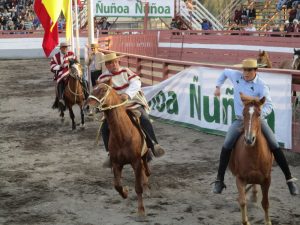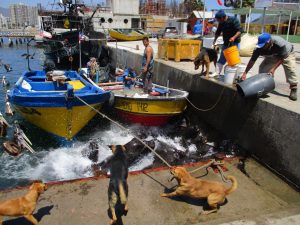by Hector Stinton, a third-year undergraduate in French and Spanish at Keble College

Chilean Spanish is the most idiosyncratic Hispanic variant, and it’s partly why I applied to work as a teacher in Santiago for my year abroad. Its earliest phonetic influence was from Andalusian conquistadores, who brought to America yeísmo (/y/ and /ll/ pronounced the same) and seseo (soft /c/ and /z/ pronounced as /s/, itself unpronounced word-finally), but it developed into a more distinctive accent with the conversion of /j/ into aspirate /h/ and the elision of /d/ in words like ciudad. Chile’s geo-political isolation made its patois evolve rapidly and hermetically: separated from its neighbours by the Andes and the Atacama until the 19th century, and with relations soured by conflict and suspicion since then, Chileanese became a point of national pride.

As in other Latin countries, the diminutive –ito/a is used to express affection and diminish the urgency, directness or importance of something, e.g. making something annoying seem more pleasant, and the voseo (use of vos as a second person singular pronoun instead of tuteo) forms the bottom two of the four grades of formality, below tú and usted. Interestingly, however, among friends, Chileans prefer the Italianate –ai or –ei ending to the Iberian –as or –es when using tú in the present tense. More unusual still is the replacement of nuestro ‘our’ with de nosotros, and the rejection of vosotros in favour of ustedes for ‘you plural’.
But above all, Chilean-speak is known for its plethora of peculiar idioms and neologisms, known as chilenismos; look in any Spanish dictionary, and you will see they predominate over all other vernaculars. There are three broad categories: Argentine / Rioplatense / Lunfardo (argot from Buenos Aires and Montevideo) terms carrying either covert prestige or criminal Coa undertones (hacer perro muerto ((literally, ‘to do a dead dog’)) – ‘to dine and dash’); Mapudungun / Quechua loanwords (copihue – Chile’s national flower, huaso – ‘cowboy’); and French / (Swiss-)German / English / Croat loanwords (confort – ‘loo paper’, lumpen – ‘lower class’, cachar – ‘to catch one’s drift’, corbata – ‘tie’). Together, they further enrich the Chilean dialect, which never fails to surprise and delight.
Some Chilenismos
hacer perro muerto – to dine and dash
huaso – cowboy
confort – loo paper
cachar – to catch one’s drift

